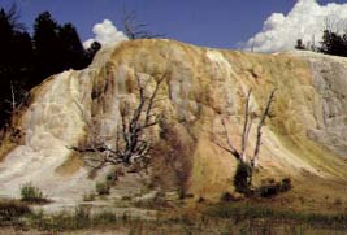Travel Reference
In-Depth Information
The next large parking area has an interpretive sign about Fort Yellowstone and an out-
standing view of Mammoth and the entire region. This terrace rim was historically called
he
Esplanade.
The road turns sharply left at The Esplanade, where
Cheops Mound
and Narrow Gauge
Terrace's travertine are crumbling on the right. The next small parking area is for
Prospect
Springs,
which are now-dry pools and a foot-high (30 cm) cone that date from about 1935.
Across the road from these springs are fenced-off deep holes that emit carbon dioxide and hy-
drogen sulfide.
Park across the road from New Highland Terrace to see the beautiful and very active lower
section of
Narrow Gauge Terrace.
The old Narrow Gauge is a cracked fissure ridge named
when it was thought to resemble a narrow-gauge railway roadbed. To reach the active springs,
walk back down the road to a short trail through the trees to connect with the Howard Eaton
Trail. Take the main trail a short distance to the north (right). The trail was relocated higher
on the hill to accommodate the spreading runoff of Narrow Gauge. Covering some of the un-
disturbed pool is sometimes a delicate, thin crust of travertine, called calcite ice.
New Highland Terrace
is known to have been active from at least 1928 and was truly spec-
tacular from the late 1950s into the 1970s. The many dead trees on the sides and top of this
formation attest to the sequence of active growth followed by inactivity. Trees grew for many
years after the hot water ceased flowing; subsequently, further hot spring activity killed the
trees. New activity has appeared at the top in the last year or two.
Orange Spring Mound (late 1990s)
On the inside of a sharp curve is
Orange Spring Mound,
composed of several cone-type
formations grown together and a fissure ridge along its long axis, colored orange by bacterial
mats. A jet at the top sometimes spouts to 3 or 4 feet (1 m). Recent activity from spouts at the
roadside edge has necessitated moving the road farther away. One of Orange Spring Mound's
often-active hot springs is named
Tangerine Spring.

